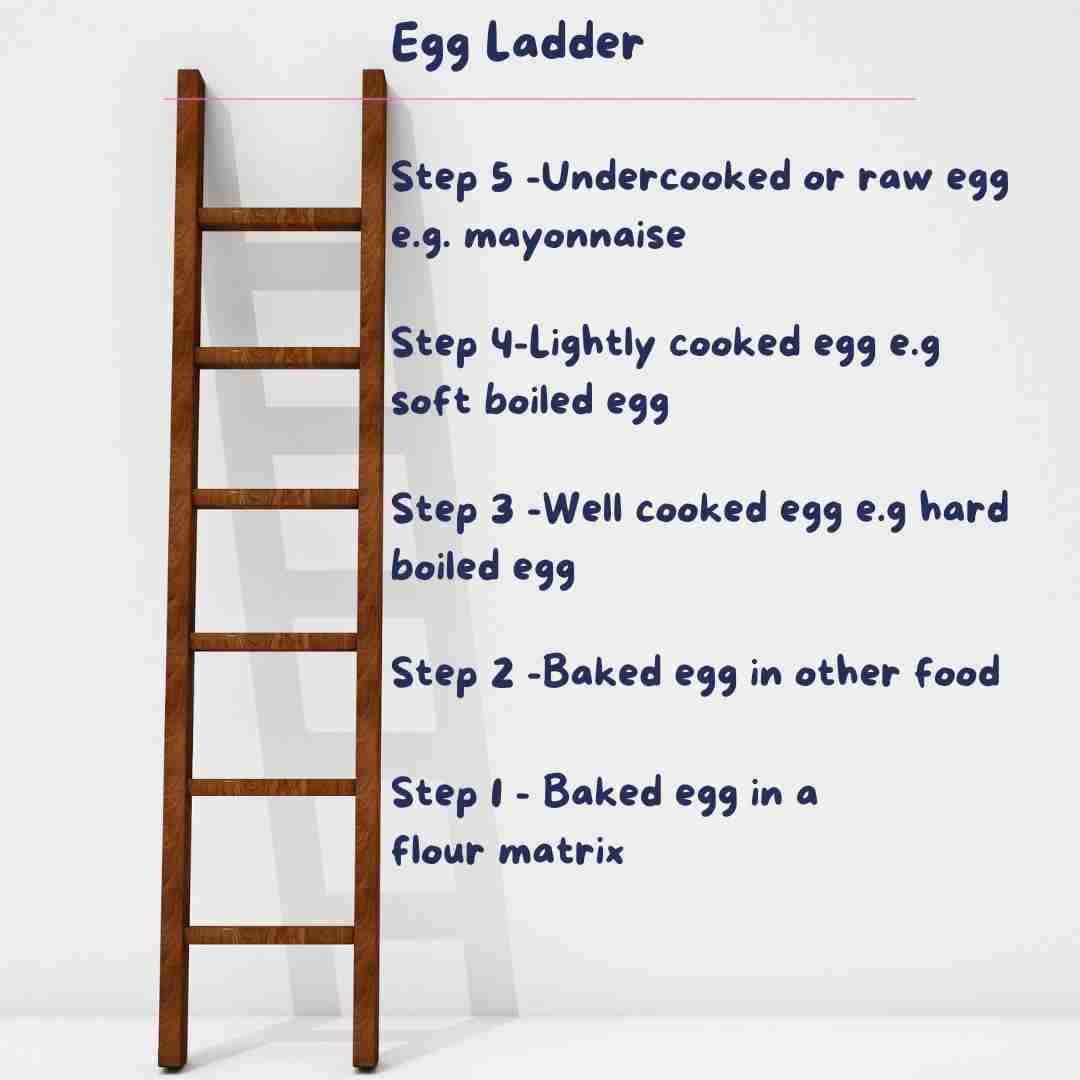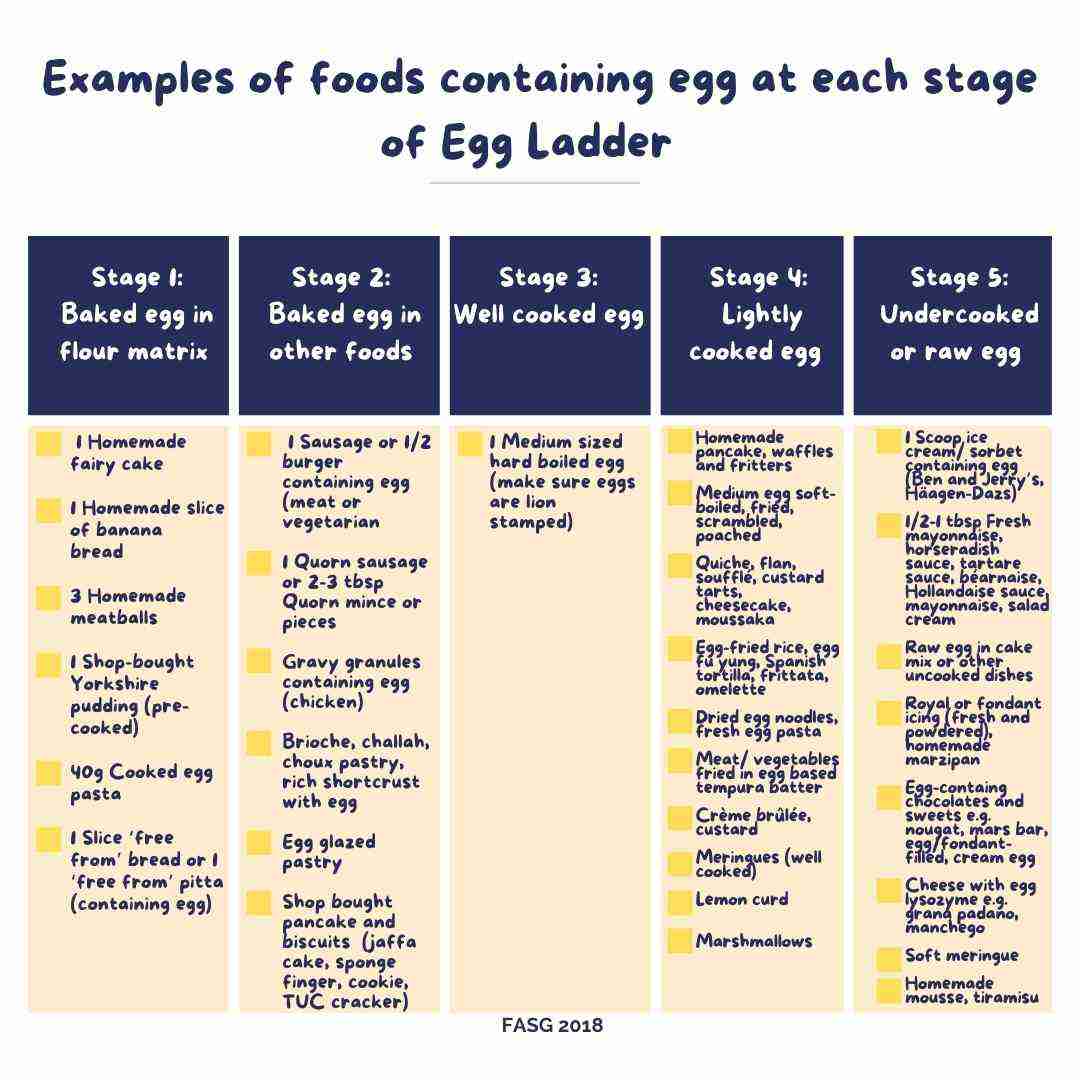The Egg Ladder
The BSACI guidelines for management of egg allergy include guidance on home egg reintroduction (the egg ladder). The following step-by-step reintroduction guide is intended for those who have already discussed with their child’s dietitian or doctor that they are safe to begin home egg reintroduction with their child and will not require referral to an allergy clinic (normally recommended for those with respiratory reactions e.g. coughing, wheezing, hoarse cry, stridor).
Eggs can play a significant role in many children’s diet. They are a common ingredient in many different foods and are the cheapest animal source for protein, iron, vitamin A and B12 (1).
Excluding eggs alone in your child’s diet may not lead to nutritional deficiencies but the risk is increased if your child has additional allergies such as milk and peanut (commonly associated with egg allergy) or other dietary exclusions resulting from lifestyle, religious and cultural practices.
The British Society for Allergy and Clinical Immunology (BASCI) has produced guidelines on management of egg allergy and recommends that a registered dietitian should be involved from diagnosis to help ensure nutritional adequacy (2)
For parents of a child with an egg allergy, you will know the difficulty faced trying to avoid eggs in your child’s diet already. It is estimated that 2% (1 in 50) children have an egg allergy. Although many will eventually outgrow this allergy, in fact, only 0.1% of adults are estimated to have an egg allergy (3), it can be fearful process to begin reintroduction of egg into your child’s diet for both you and your child.
A checklist before starting the egg ladder
- Have spoken with your child’s dietitian or doctor about starting egg reintroduction Your child is well and any hay-fever, eczema or asthma controlled (if used their inhaler in the last three days then delay starting introduction)
- Tolerating any prescribed medication for at least 2 weeks and should remain on this as advised
- Able to observe your child for any potential response 2 hours post-meal
When to start egg ladder
Children without any asthma or well controlled mild asthma or have only mild skin symptoms could try a small amount of baked egg (pea sized e.g sponge cake) from around 12 months at home (4).
• Do not introduce any other new foods at the same time and make sure when introducing each food that they do not contain any other ingredients your child is allergic to
• Do not force your child if they refuse to eat a certain food- if having difficulty reintroducing, refer to your dietitian or doctor
• Three days in between each stage minimum (more if you or medical professional feel needed)
• Keeping a food and symptom diary to observe any delayed reactions
• Stop giving food if unsure if child is having a delayed reaction and speak with your doctor or dietitian about whether to continue (4).
What do I do in the event of an allergic reaction?
If your child begins to display any of the immediate-type (IgE mediated) allergic responses (hives, red rashes, runny nose, sneezing, itchiness, swelling, coughing, wheezing, breathing difficulty, vomiting), stop feeding them the food and seek medical attention. This is unlikely to occur as your child is unlikely to have an immediate-type allergy if advised to begin a home egg reintroduction.
In the event of a delayed (non-IgE mediated food allergy), you will notice a reaction between 2 hours and up to 3 days. If your child begins to display any of the delayed-type (non-IgE mediated allergy) responses which normally occur between 2 hours and 3 days (abdominal pain, increased wind and nausea, sudden change in bowel habits), then stop feeding the current food and go back to the type of egg your child can tolerate. Remain on this type of egg, including a variety of all egg tolerated, for 6 months before trying again (4).

The Egg Ladder
Stage 1: Baked egg in a flour matrix:
The first stage is to introduce your child to a small portion of well cooked egg baked in a flour matrix.
The suggested food to start with is a homemade fairy cake using the recipe below (5)
1. Give your child a pea sized amount of the fairy cake on day 1 (1/16)
2. It will depend on your child’s tolerance (displaying no symptoms), increase the portion by double each day until your child can tolerate a full portion (1 fairy cake)
3. Try to make sure your child continues to eat this food regularly once tolerated
4. Next try introducing your child to other foods from the baked egg in a flour category (see food tolerance checklist below) and can use the other recipes listed for homemade banana bread and meatballs
Egg Ladder Recipes
Homemade fairy cakes
Ingredients:
1 egg
110g butter
110g sugar
110g self-raising flour
Method
1. Preheat oven to 180 degrees C / gas mark 4
2. Cream butter and sugar
3. Mix in egg and fold in flour
4. Spoon between 8 fairy cakes and bake for 10-15 minutes
Homemade banana bread
Ingredients:
1 egg
1 large mashed banana
180g plain flour
2 tsp baking powder
½ tsp cinnamon
1 tsp vanilla essence
60ml vegetable oil
120g caster sugar (optional)
Method:
1. Preheat oven to 180 degrees C / gas mark 4
2. Line a small loaf tin with baking paper
3. Blend egg, vegetable oil and mashed banana
4. Add dry ingredients to wet and mix
5. Pour into the tin and bake for 30 minutes
Homemade meatballs
Ingredients:
500g mince (beef/chicken/turkey)
60g breadcrumbs
1 medium egg
1 shallot (chopped fine)
Mixed herbs, salt and paper
Method:
1. Preheat oven to 180 degrees C / gas
2. Mix ingredients together
3. Roll into 20 equal-sized balls
4. Put onto oiled baking tray and bake for 20 minutes
5. Serve with sauce, mashed potato, rice or vegetables
Stage 2: Baked egg in other food
Once your child is tolerating a range of foods from stage 1, you can begin to give your child baked egg in other foods. It is advised to choose one of these options to begin with before including the remaining foods listed in this stage on the checklist:
• 1 sausage or ½ burger containing egg
• 1 QuornTM sausage or 2-3 tbsp of QuornTM mince or pieces
Stage 3: Well cooked egg
If your child is tolerating foods from stages 1 and 2, you can introduce a medium hardboiled egg. Then as with any food introduced so far, start with a small pea-sized amount, and double the portion daily until a full portion is tolerated.
Stage 4: Lightly cooked egg e.g. soft boiled egg
Once your child is tolerating a hard-boiled egg, it is time to introduce lightly cooked egg in any of the following forms: scrambled, soft-boiled, fried, omelette, pancakes*.
Next is to try other foods in this category once your child tolerates one of these lightly cooked egg-contains foods.
*You may start with a meringue (shop or homemade with hard centre) but speak with your dietitian if doing so as you may need to add a further step before introducing other foods in this category as meringues only contain the egg white.
Stage 5: Undercooked or raw egg e.g. mayonnaise
This is the final stage is undercooked or raw egg. Next try one of the following options to introduce slowly, starting with a trace amount:
• 1 scoop ice cream containing egg
• ½ – 1 tbsp fresh mayo. start with trace amounts.
Once your child can tolerate one of these options, you can begin to introduce other options in this category (5).

Conclusion
The whole process can vary in time taken to reach the final stage depending on your child. It maybe that your child may only tolerate well-cooked egg (allergy to well-cooked egg resolves in 68% of cases by aged 16 (6). The most important thing to remember is that every child is different and to not rush the process.
If you’d like more like this, you can find more from me by downloading my new e-book or mini milk allergy course or for a one-to-one consultations, visit www.dietitianwithadifference.co.uk or follow me on instragram @dietitian.withadifference
Thank you to Hannah Eiseman Student Dietitian for helping with researching and writing the blog.




